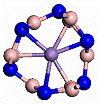Department of Physics and Astronomy: Publications and Other Research
Date of this Version
2013
Citation
Published in Journal of Physical Chemistry Letters, 4:20 (2013), pp. 3413–3419; doi: 10.1021/jz4016124
Abstract
A study of the two-dimensional crystallization of rhodizonic acid on the crystalline surfaces of gold and copper is presented. Rhodizonic acid, a cyclic oxocarbon related to the ferroelectric croconic acid and the antiferroelectric squaric acid, has not been synthesized in bulk crystalline form yet. Capitalizing on surface-assisted molecular self-assembly, a two-dimensional analogue to the well-known solution-based coordination chemistry, two-dimensional structures of rhodizonic acid were stabilized under ultrahigh vacuum on Au(111) and Cu(111) surfaces. Scanning tunneling microscopy, coupled with first-principles calculations, reveals that on the less reactive Au surface, extended two-dimensional islands of rhodizonic acid are formed, in which the molecules interact via hydrogen bonding and dispersion forces. However, the rhodizonic acid deprotonates into rhodizonate on Cu substrates upon annealing, forming magic clusters and metal–organic coordination networks with substrate adatoms. The networks show a 2:1 distribution of rhodizonate coordinated with 3 and 6 Cu atoms, respectively. The stabilization of crystalline structures of rhodizonic acid, structures not reported before, and their transition into metal–organic networks demonstrate the potential of surface chemistry to synthesize new and potential useful organic nanomaterials.
Includes Supplemental Information.


Comments
Copyright © 2013 American Chemical Society. Used by permission.